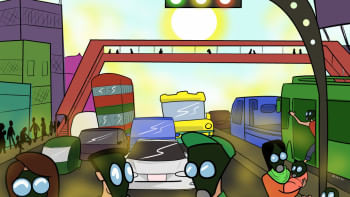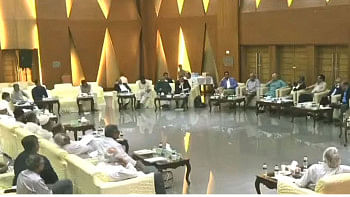Are school buses the answer to our traffic woes?

We're all familiar with the sight: rows of cars parked outside schools to drop off and pick up students across Dhaka. And we all suffer from the consequent congestion, noise, and danger to all those who are not in cars. Clearly, our system of allowing and even encouraging the elite to drive their children to and from school in their own automobiles is contributing to our urban misery. But what is the solution?
The answer that is on many people's minds is school buses. Buses, after all, can transport large numbers of children in the space occupied by only about two cars. There is logic to this solution, or at least the appearance of it.
Where's the problem? First of all, school buses only operate on the days that schools are open, and then only twice a day. The rest of the time they are parked somewhere. This is an incredibly inefficient use of space and money. In the US, the government spends $21 billion a year just on transporting children to and from school by bus. The investment in school buses would be much better spent on improving the overall public transit system so that not just students but everyone could benefit, and the buses would be moving throughout the day. (I'm kidding; they would mostly be stuck in traffic caused by all the cars).
Secondly, why do we assume that children are travelling great distances to school? In most cases, children should attend a neighbourhood school that is within walking or cycling distance. If no school is available, then other schools should be encouraged to build satellite schools. It is a waste of children's time to be stuck in a bus for hours every day.
Children benefit in many ways when they travel to school actively, that is, by foot or bicycle: they are more prepared to learn when they arrive in school; they concentrate better and fidget less. In addition to the cognitive benefits are the physical ones, of gaining much-needed exercise, and the social benefits when they travel to school with friends or family. Not only do they benefit, but streets are less congested, polluted, and dangerous when there are fewer cars and more people on foot and bicycle.
Certainly, asking children to walk or cycle to school on the current Dhaka streets may seem cruel. But if we cannot provide a positive environment for children to travel actively and safely to school, then we are failing as a city and should take measures to fix the problems, rather than allowing the elite to retreat into their steel boxes and everyone else to suffer.
The problem, though almost uniquely bad in Dhaka, is certainly not limited to our capital city. Faced with the unacceptable situation of child injury and death on the roads, New York and California both invested funds in improving the physical environment for walking and cycling. The states thus achieved, respectively, a 44 percent and 75 percent decline in injuries and crashes involving children. Paris is creating 300 "School Streets" that are accessible, cooler, and greener, and include bicycle networks, children's games, and street furniture. Barcelona, in addition to its superblocks and School Streets, is also organising a BiciBus in different neighbourhoods, in which around 50 children and parents cycle to school together. The BiciBus is a variation on the popular Walking School Bus, whereby children are organised to walk to school safely together.
But we needn't look so far away. In India, on average, 45 children die on the roads each day. That is an outrageous figure. Rather than simply accept it as the cost of modernity, the Indian government is working to make streets safer. One such example is the "250 metres of happiness" project in Delhi, launched in collaboration with government and other agencies and led by HumanQind, a non-profit design foundation. The project enables children to take the lead in planning safe, attractive, and stimulating environments to travel actively to school. The redesigned street includes a segregated cycle way, tree plantation, an outdoor gym, learning aids, play spaces incorporated into the footpath, and spaces for vendors. While in the past, cars were parked on the footpath and children and their guardians walked in the street, the footpaths have been reclaimed for people.
Whether it's the Walking School Bus, the BiciBus, School Streets, or 250 metres of happiness, there are plenty of great international examples of ways to improve the traffic situation around schools while making children's—and everyone else's—lives better. And all are far more affordable and practical than school buses.
Debra Efroymson is executive director of the Institute of Wellbeing, Bangladesh.
Views expressed in this article are the author's own.
Follow The Daily Star Opinion on Facebook for the latest opinions, commentaries and analyses by experts and professionals. To contribute your article or letter to The Daily Star Opinion, see our guidelines for submission.

 For all latest news, follow The Daily Star's Google News channel.
For all latest news, follow The Daily Star's Google News channel. 








Comments